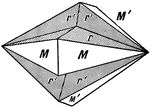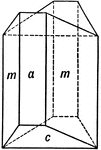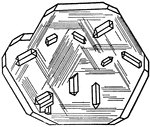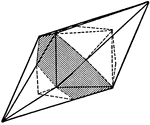
Arsenopyrite
Iron Sulpharsenide (Arsenopyrite), bounded by ∞P, {110} (M), and 1/3P∞̆, {013} (r), forms penetration…

Malachite
The most common twinning plane is the orthopinacoid ∞P∞̄ , {100}, as may be seen in this example…

Rutile Growing Upon Titanic Iron
The tetragonal rutile grows upon the rhombohedral titanic iron, so that its prism of the second order,…

Green Fluorspar from Saxony
Certain crystals of green fluorspar from Saxony, showing the form ∞ 03, {310}, have one half of their…

Striation of Crystal Planes
Striation of crystal planes may be produced by repeated polysynthetic twinning. This is well illustrated…